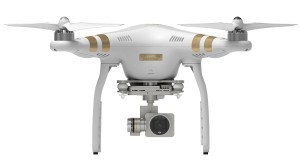 DJI has released an update to its DJI Phantom and Phantom 2 models, called (predictably enough…) the DJI Phantom 3. Having released the $3,000 “prosumer” Inspire 1 model last year, DJI has now trickled down a number of its features onto the more consumer level Phantom model. So does this new model have the competition beat, and how does it compare to the previous DJI Phantom models?
DJI has released an update to its DJI Phantom and Phantom 2 models, called (predictably enough…) the DJI Phantom 3. Having released the $3,000 “prosumer” Inspire 1 model last year, DJI has now trickled down a number of its features onto the more consumer level Phantom model. So does this new model have the competition beat, and how does it compare to the previous DJI Phantom models?
DJI has in fact introduced two new models – the $999 Phantom 3 Advanced, with 1080p60 video capability, and the $1,259 Phantom 3 Professional featuring 4K video resolution. To the 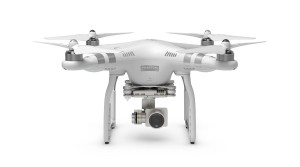 untrained eye, the Phantom 3 models look largely identical to the previous Phantom models – the basic body shape is identical, although the design of the landing gear has changed slightly. The Advanced model sports silver bands on its rotor arms (replacing the red on the Phantom 2), while the Professional model shows of its range-topping status with gold bands. Phantom 3 also features a new battery with 4480mAh, which gives a maximum flight time of around 23 minutes. Interestingly, DJI have equipped the Professional with a 100W charger for faster charging, while the Advanced model has to make do with only a 57W charger.
untrained eye, the Phantom 3 models look largely identical to the previous Phantom models – the basic body shape is identical, although the design of the landing gear has changed slightly. The Advanced model sports silver bands on its rotor arms (replacing the red on the Phantom 2), while the Professional model shows of its range-topping status with gold bands. Phantom 3 also features a new battery with 4480mAh, which gives a maximum flight time of around 23 minutes. Interestingly, DJI have equipped the Professional with a 100W charger for faster charging, while the Advanced model has to make do with only a 57W charger.
The control unit is, however, considerably different to that on the Phantom 2 model, and is in fact based on that for the DJI Inspire 1 model. Notably, it now incorporates a mount for an iOS or Android phone or tablet, which connects to the control via a single lead, and then (via the DJI 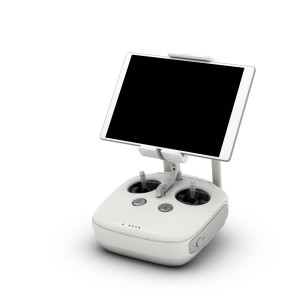 app) acts as the control centre for the Phantom 3. DJI’s Lightbridge technology is built-in to the Phantom 3, meaning that the drone can live stream 720p footage to the phone or tablet app, at a range of over a mile, allowing the user to fly the drone from a first person view (FPV) perspective, and also see exactly what is being captured by the camera. Meanwhile the full resolution footage (1080p for the Advanced, 4K for the Professional) is stored on a micro SD card. While the previous Phantom 2 Vision + also allowed video streaming, this utilised a wifi connection rather than the Lightbridge link, and as such the range and quality of the live feed were much more limited.
app) acts as the control centre for the Phantom 3. DJI’s Lightbridge technology is built-in to the Phantom 3, meaning that the drone can live stream 720p footage to the phone or tablet app, at a range of over a mile, allowing the user to fly the drone from a first person view (FPV) perspective, and also see exactly what is being captured by the camera. Meanwhile the full resolution footage (1080p for the Advanced, 4K for the Professional) is stored on a micro SD card. While the previous Phantom 2 Vision + also allowed video streaming, this utilised a wifi connection rather than the Lightbridge link, and as such the range and quality of the live feed were much more limited.
Another feature brought across from the Inspire 1 is downward-facing “Vision Positioning System” (seen in the picture here on the underside of the Phantom 3 Advanced). This comprises a camera which looks directly down from the bottom of the drone, and 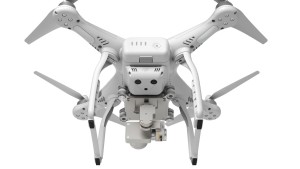 can detect forward, lateral and vertical movement, allowing the quadcopter to correct for it. This enables the Phantom 3 to hover almost completely still when operating inside or in an area with poor GPS coverage – DJI claim an accuracy of 0.1m when the system is operative. The system only works when the Phantom is in the altitude range of 0.3 – 3m, and when there is adequate lighting and a surface with a clear pattern to work from. The Phantom also features ultrasonic sensors which allow it to be flown inside with a much lower risk of hitting the walls (though care still needs to taken!)
can detect forward, lateral and vertical movement, allowing the quadcopter to correct for it. This enables the Phantom 3 to hover almost completely still when operating inside or in an area with poor GPS coverage – DJI claim an accuracy of 0.1m when the system is operative. The system only works when the Phantom is in the altitude range of 0.3 – 3m, and when there is adequate lighting and a surface with a clear pattern to work from. The Phantom also features ultrasonic sensors which allow it to be flown inside with a much lower risk of hitting the walls (though care still needs to taken!)
One trick which is missing from the Phantom 3 is the ability to plot a course on the app, and then have the drone fly this autonomously. This is something that will soon be available on the Parrot BeBop via an in-app purchase, and so it is not inconceivable that DJI will update its own app in due course to bring this functionality to the Phantom, given that all the necessary hardware is in place.
As for the cameras, the Advanced model can shoot at full HD 1080p resolution at 60 fps; it can also shoot at 720p at the same framerate. Meanwhile, the range topping Professional model 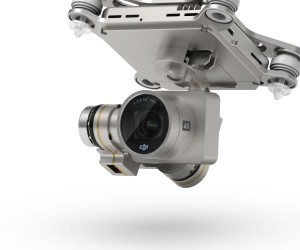 has the same image sensor as the Inspire 1 and shoots at 4K at 30 fps, matching the GoPro Hero 4 Black. Both Phantom 3 models can also shoot 12MP still photos in both raw and jpeg formats, either on a single shot, burst or timelapse setting. The camera on both models features a 94 degree field of view, which gives minimal distortion – in a thinly-veiled dig at GoPro’s wide angle lens, DJI state that this is to eliminate “the unwanted lens distortion common in other cameras not built to shoot from the air”. While it is possible to shoot with a medium or narrow field of view on a GoPro, this is only available at certain resolutions – notably on the Hero 4 Black, a medium field of view can be selected at 2.7K, and a narrow FOV at 1080p – but if you want to shoot at 4K, it can only be in an ultra wide setting. As such, the Phantom 3 Professional potentially provides a better solution for 4K aerial footage than mounting a GoPro on a drone.
has the same image sensor as the Inspire 1 and shoots at 4K at 30 fps, matching the GoPro Hero 4 Black. Both Phantom 3 models can also shoot 12MP still photos in both raw and jpeg formats, either on a single shot, burst or timelapse setting. The camera on both models features a 94 degree field of view, which gives minimal distortion – in a thinly-veiled dig at GoPro’s wide angle lens, DJI state that this is to eliminate “the unwanted lens distortion common in other cameras not built to shoot from the air”. While it is possible to shoot with a medium or narrow field of view on a GoPro, this is only available at certain resolutions – notably on the Hero 4 Black, a medium field of view can be selected at 2.7K, and a narrow FOV at 1080p – but if you want to shoot at 4K, it can only be in an ultra wide setting. As such, the Phantom 3 Professional potentially provides a better solution for 4K aerial footage than mounting a GoPro on a drone.
Although the Advanced and the Professional are the only Phantom 3 models that DJI has announced so far, it seems quite likely that it will release a ‘naked’ Phantom 3 drone without a camera at some point in the future – this would allow a user to attach their own gimbal and GoPro (or other) action cam – much like the DJI Phantom 2 did. If DJI does release a version like this, it will be interesting to see how its pricing compares to the camera included Advanced and Professional models, and the extent to which (if at all) DJI’s Lightbridge technology will work with the GoPro camera. We would be surprised if the cost of a “naked” Phantom 3 plus a GoPro Hero 4 Silver or Black will end up being less than the cost of a Phantom 3 Advanced / Professional with the camera built in, and while there are some advantages to the drone + GoPro option (as we explore here) it may well be that the majority of users will opt to go for a camera-carrying DJI Phantom 3, particularly if (as discussed above) 4K footage is a priority.
 DJI have now discontinued the Phantom 1 and 2 models, so in the future the Phantom 3 Professional and Advanced models will be the only Phantoms available. For now though, both of the earlier Phantom models are still available, and we expect that they are likely to be heavily discounted as retailers use up their existing stock. However, for most users the Phantom 3 models offer an increase in functionality and usability that makes them worth the extra over the potentially discounted earlier models. In particular, the vastly improved live streaming functionality, and the Vision Positioning System allowing the ability to fly more accurately indoors or close to the ground, are worth the price of entry, and just under $1000 for the Phantom 3 Advanced actually looks like pretty good value. As to whether you want to step up to the Phantom 3 Professional – well, that depends on your need and/or desire to step up to a 4K resolution (see our article to help you decide here!), but the extra $260 seems about the right price for the extra resolution (not to mention the better charger and the snazzy gold strips!)
DJI have now discontinued the Phantom 1 and 2 models, so in the future the Phantom 3 Professional and Advanced models will be the only Phantoms available. For now though, both of the earlier Phantom models are still available, and we expect that they are likely to be heavily discounted as retailers use up their existing stock. However, for most users the Phantom 3 models offer an increase in functionality and usability that makes them worth the extra over the potentially discounted earlier models. In particular, the vastly improved live streaming functionality, and the Vision Positioning System allowing the ability to fly more accurately indoors or close to the ground, are worth the price of entry, and just under $1000 for the Phantom 3 Advanced actually looks like pretty good value. As to whether you want to step up to the Phantom 3 Professional – well, that depends on your need and/or desire to step up to a 4K resolution (see our article to help you decide here!), but the extra $260 seems about the right price for the extra resolution (not to mention the better charger and the snazzy gold strips!)
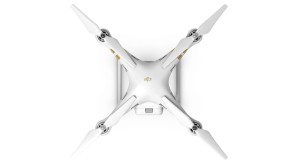 What about the other competition? The Parrot BeBop is half the price of the Phantom 3 Advanced, and also offers 1080p resolution. However, without the additional SkyController bundle it doesn’t offer anything like the same usability and range as the Phantom 3, and adding the controller package in takes the price to nearly $900 – very close to the Phantom 3 Advanced. For that money, we think that the physical gimbal of the Phantom 3 is likely to outperform the clever electronic image stabilisation employed by the BeBop. Meanwhile the 3DR Solo offers some interesting functionality (full review coming soon…), but at nearly $1000 without a gimbal or a GoPro, it is a more expensive proposition than the Phantom. Overall then, the Phantom 3 has reestablished DJI as the leader of the high-end consumer drone market, and for the moment, it does appear to be the go-to quadcopter option for those with around $1000 to play with.
What about the other competition? The Parrot BeBop is half the price of the Phantom 3 Advanced, and also offers 1080p resolution. However, without the additional SkyController bundle it doesn’t offer anything like the same usability and range as the Phantom 3, and adding the controller package in takes the price to nearly $900 – very close to the Phantom 3 Advanced. For that money, we think that the physical gimbal of the Phantom 3 is likely to outperform the clever electronic image stabilisation employed by the BeBop. Meanwhile the 3DR Solo offers some interesting functionality (full review coming soon…), but at nearly $1000 without a gimbal or a GoPro, it is a more expensive proposition than the Phantom. Overall then, the Phantom 3 has reestablished DJI as the leader of the high-end consumer drone market, and for the moment, it does appear to be the go-to quadcopter option for those with around $1000 to play with.
